Study on Damage Evolution and Resistivity Variation Regularities of Coal Mass Under Multi-Stage Loading
Abstract
:Featured Application
Abstract
1. Introduction
2. Experiment Test
2.1. Sample Preparation
2.2. Sample System
3. Experimental Results and Analysis.
3.1. Electrical Resistivity Variation Characteristics
3.2. Damage Evolution Analysis of Coal Sample
4. The Influence of Damage Evolution on Electrical Resistivity
4.1. The Establishment of AE Damage Model
4.2. The Relationship between AE Damage Variable and Electrical Resistivity
5. Discussion
6. Conclusions
- (1)
- There is a good correspondence relationship between the resistivity variation curve and stress variation curve in the mass under multi-stage loading. The electrical resistivity will decrease step by step with the gradual increasing of stress, and when the load continues to increase and reach the ultimate compressive strength of coal mass, the electrical resistivity is abruptly increasing to maximum.
- (2)
- AE messages can be used to reveal effectively damage evolution process of microcracks formation, expansion and fracture in loading coal. And the curve of AE cumulative ringing count has three different types of growth trends, i.e., table stage, sudden change stage, gradual increasing stage, during the compression process.
- (3)
- Combining the different sensitivity of acoustic emission and resistivity to deformation and failure of coal-rock mass, the relationship between resistivity and AE accumulative ringing count is established, and its rationality is verified. And it is more comprehensive and precise to understand the evolution process of coal-rock dynamic disasters and understand the evolution process of coal-rock dynamic disasters.
Author Contributions
Funding
Acknowledgments
Conflicts of Interest
References
- Xue, D.; Wang, J.; Zhao, Y.; Zhou, H. Quantitative determination of mining-induced discontinuous stress drop in coal. Int. J. Rock Mech. Min. 2018, 111, 1–11. [Google Scholar] [CrossRef]
- Xue, J.; Wang, H.; Zhou, W. Experimental research on overlying strata movement and fracture evolution in pillarless stress-relief mining. Int. J. Coal Sci. Technol. 2015, 2, 38–45. [Google Scholar] [CrossRef] [Green Version]
- Chen, P.; Wang, E.; Chen, X.; Liu, Z.; Li, Z.; Shen, R. Regularity and mechanism of coal resistivity response with different conductive characteristics in complete stress-strain process. Int. J. Min. Sci. Technol. 2015, 25, 779–786. [Google Scholar] [CrossRef]
- Yang, X.; Xia, Y.; Wang, X. Investigation into the nonlinear damage model of coal containing gas. Saf. Sci. 2012, 50, 927–930. [Google Scholar] [CrossRef]
- Liu, X.; Tan, Y.; Ning, J.; Lu, Y.; Gu, Q. Mechanical properties and damage constitutive model of coal in coal-rock combined body. Int. J. Rock Mech. Min. 2018, 110, 140–150. [Google Scholar] [CrossRef]
- Bai, J.; Feng, G.; Wang, Z.; Wang, S.; Qi, T.; Wang, P. Experimental investigations on the progressive failure characteristics of a sandwiched coal-rock system under uniaxial compression. Appl. Sci. 2019, 9, 1195. [Google Scholar] [CrossRef]
- Yang, S.; Jing, H. Strength failure and crack coalescence behavior of brittle sandstone samples containing a single fissure under uniaxial compression. Int. J. Fract. 2011, 168, 227–250. [Google Scholar] [CrossRef]
- Cao, A.; Jing, G.; Ding, Y.; Liu, S. Mining-induced static and dynamic loading rate effect on rock damage and acoustic emission characteristic under uniaxial compression. Saf. Sci. 2019, 116, 86–96. [Google Scholar] [CrossRef]
- Wang, C.; Hou, X.; Liao, Z.; Chen, Z.; Lu, Z. Experimental investigation of predicting coal failure using acoustic emission energy and load-unload response ratio theory. J. Appl. Geophys. 2019, 161, 76–83. [Google Scholar] [CrossRef]
- Kong, X.; Wang, E.; He, X.; Zhao, E.; Zhao, C. Mechanical characteristics and dynamic damage evolution mechanism of coal samples in compressive loading experiments. Eng. Fract. Mech. 2019, 210, 160–169. [Google Scholar] [CrossRef]
- Zhang, Z.; Wang, E.; Li, N.; Li, X.; Wang, X.; Li, Z. Damage evolution analysis of coal samples under cyclic loading based on single-link cluster method. J. Appl. Geophys. 2018, 152, 56–64. [Google Scholar] [CrossRef]
- Chen, G.; Lin, Y. Stress–strain–electrical resistance effects and associated state equations for uniaxial rock compression. Int. J. Rock Mech. Min. 2004, 41, 223–236. [Google Scholar] [CrossRef]
- Wang, Y.; Wang, J.; Yan, S. Experimental research on electrical parameters variation of loaded coal. Dig. J. Nanomater. Bios. 2011, 26, 890–897. [Google Scholar]
- Li, S.; Xu, X.; Liu, Z.; Yang, W.; Liu, B.; Zhang, X.; Wang, Z.; Nie, L.; Li, J.; Xu, L. Electrical resistivity and acoustic emission response characteristics and damage evolution of sandstone during whole of uniaxial compression. Chin. J. Rock Mech. Eng. 2014, 33, 14–23. [Google Scholar] [CrossRef]
- Qi, T.; Feng, G. Resistivity and AE response characteristics in the failure process of CGB under uniaxial loading. Adv. Mater. Sci. Eng. 2017, 2017, 1–11. [Google Scholar] [CrossRef]
- Li, Z.; Lou, Q.; Wang, E.; Liu, S.; Niu, Y. Study on acoustic–electric–heat effect of coal and rock failure processes under uniaxial compression. J. Geophys. Eng. 2018, 15, 71–80. [Google Scholar] [CrossRef]
- Wang, Y.; Liu, Y.; Ma, H. Changing regularity of rock damage variable and resistivity under loading condition. Saf. Sci. 2012, 50, 718–722. [Google Scholar] [CrossRef]
- X, X.; B, L.; S, L.; J, S.; M, L.; J, M. The electrical resistivity and acoustic emission response law and damage evolution of limestone in brazilian split test. Adv. Mater. Sci. Eng. 2016, 2016, 1–8. [Google Scholar]
- Lyu, C.; Hao, S.; Sun, Q. Experiment study on the correlation between the CO2 adsorption capacity and electrical resistivity of coal with temperature effect. Greenh. Gases 2019. [Google Scholar] [CrossRef]
- Zheng, C.; Liu, X.; Yan, P.; Zhang, Y. Measurement and prediction of fly ash resistivity over a wide range of temperature. Fuel 2018, 216, 673–680. [Google Scholar] [CrossRef]
- Guo, X.; Huan, X.; Gong, W.; Zhang, Y. Study on coal complex resistivity anisotropy and characteristics of frequency response. Coal Sci. Technol. 2017, 45, 167–170. [Google Scholar]
- Li, N.; Wang, E.; Zhao, E.; Ma, Y.; Xu, F.; Qian, W. Experiment on acoustic emission of rock damage and fracture under cyclic loading and multi-stage loading. J. China Coal Soc. 2010, 35, 1099–1103. [Google Scholar]
- Invernizzi, S.; Lacidogna, G.; Carpinteri, A. Particle-based numerical modeling of AE statistics in disordered materials. Meccanica 2013, 48, 211–220. [Google Scholar] [CrossRef]
- Patil, P.A.; Gorek, M.; Folberth, M.; Hartmann, A.; Forgang, S.; Fulda, C.; Reinicke, K. Electrical resistivity and permittivity measurements of oil base muds in the frequency range from 1 MHz to 100 MHz. SPE Drill. Completion 2010, 25, 380–390. [Google Scholar] [CrossRef]
- Zhu, H.; Wang, W.; Wang, H.; Zhao, H.; Xin, M. Study on electrical properties of coal at spontaneous combustion characteristic temperature. J. Appl. Geophys. 2018, 159, 707–714. [Google Scholar] [CrossRef]
- Nitsan, U. Electromagnetic emission accompanying fracture of quartz-bearing rocks. Geophys. Res. Lett. 1977, 4, 333–336. [Google Scholar] [CrossRef]
- Yin, S.; Li, Z.; Niu, Y.; Qiu, L.; Sun, Y.; Chen, F.; Wei, Y. Experimental study on the characteristics of potential for coal rock evolution under loading. J. China Coal Soc. 2017, 42, 97–103. [Google Scholar]
- Zhang, L.; Wu, Y.; Pu, H.; He, X.; Li, P. The Migration of Coalbed Methane under Mining Pressure and Air Injection: A Case Study in China. Geofluids 2018, 2018, 1–14. [Google Scholar] [CrossRef]
- Chmel, A.E.; Shcherbakov, I.N. A comparative acoustic emission study of compression and impact fracture in granite. Int. J. Rock Mech. Min. 2013, 64, 56–59. [Google Scholar] [CrossRef]
- Baddari, K.; Frolov, A.D.; Tourtchine, V.; Rahmoune, F. An integrated study of the dynamics of electromagnetic and acoustic regimes during failure of complex macrosystems using rock blocks. Rock Mech. Rock Eng. 2011, 44, 269–280. [Google Scholar] [CrossRef]
- Ji, M. Damane evolution law based on acoustic emission and weibull distribution of granite under uniaxial stress. Acta Geodyn. Geomater. 2014, 175, 1–9. [Google Scholar] [CrossRef]
- Heiple, C.; Carpenter, S. AE from Dislocation Motion; Gordon and Breach Publisher: New York, NY, USA, 1983. [Google Scholar]
- Wadley, H.; Scruby, C.; Speak, J. AE for physical examination of medals. Int. Met. Rev. 1980, 249, 41–64. [Google Scholar]
- Kachanov, L.M. Time of the rupture process under creep conditions. Izv. Akad. Nauk SSSR Otd. Tekhnicheskich Nauk 1958, 8, 26–31. [Google Scholar]
- Rabotnov, Y.N. On the equations of state for creep. In Progress in Applied Mechanics; McMillan: New York, NY, USA, 1963; pp. 307–315. [Google Scholar]
- Liu, B.; Huang, J.; Wang, Z.; Liu, L. Study on damage evolution and acoustic emission character of coal-rock under uniaxial compression. Chin. J. Rock Mech. Eng. 2009, 28, 3234–3238. [Google Scholar]
- Sun, X.; Li, E.; Duan, J.; Pu, S.; Tan, Y.; Han, Y.; Zhao, Y. Study on acoustic emission characteristics and damage evolution law of Beishan granite under triaxial compression. Chin. J. Rock Mech. Eng. 2018, 37, 4234–4244. [Google Scholar]
- Wang, E.; Chen, P.; Li, Z.; Shen, R.; Xu, J.; Zhu, Y. Resistivity response in complete stress-strain process of loaded coal. J. China Coal Soc. 2014, 39, 2220–2225. [Google Scholar]
- Li, X.; Liu, F.; Nie, B.; Wang, Y.; Li, L.; Wang, Z.; Zheng, X.; Guo, Q. The experiment of coal body electrical parameters under triaxial stress. Appl. Mech. Mater. 2013, 295–298, 2924–2927. [Google Scholar] [CrossRef]
- Chen, P.; Wang, E.; Zhu, Y. Experimental study on resistivity variation regularities of loading coal. J. China Coal Soc. 2013, 38, 548–553. [Google Scholar]
- Chen, J.; Liu, Z. Dielectric Physics; China Machine Press: Beijing, China, 1982. [Google Scholar]
- Liu, Q.; Wu, W.; Xiao, J.; Tian, Y.; Chen, J.; Singh, A. Correlation between damage evolution and resistivity reaction of concrete in-filled with graphene nanoplatelets. Constr. Build. Mater. 2019, 208, 482–491. [Google Scholar] [CrossRef]
- Datsios, Z.G.; Mikropoulos, P.N. Characterization of the frequency dependence of the electrical properties of sandy soil with variable grain size and water content. IEEE Trans. Dielect. Electr. Insul. 2019, 26, 904–912. [Google Scholar] [CrossRef]
- Bai, W.; Kong, L.; Guo, A.; Lin, R. Stress–strain–electrical evolution properties and damage-evolution equation of lateritic soil under uniaxial compression. J. Test. Eval. 2017, 45, 1247–1260. [Google Scholar] [CrossRef]
- Ji, H.; Xiang, P.; Zhang, L.; Han, F.; Yang, Z. Experimental study and detection analysis of mechanical properties variation of rock mass in excavation disturbance. Chin. J. Rock Mech. Eng. 2011, 30, 2352–2359. [Google Scholar]
- Mazzella, A. Electrical resistivity varisitions associated with earthquake on the San Andreas fault. Science 1974, 185, 1109–1118. [Google Scholar] [CrossRef] [PubMed]
- Stopinskl, W. Precursory rock resistivity variations related to mining tremors. Acta Geophys. 1982, 30, 367–379. [Google Scholar]
- Meng, L.; Liu, M.; Wang, Y. Study on the rules of electrical resistivity variation of tectonic coal in uniaxial compression experiment. J. China Coal Soc. 2010, 35, 2028–2032. [Google Scholar]
- Dindi, H.; Bai, X.; Krantz, W. Thermal and electrical property measurements for coal. Fuel 1989, 68, 185–192. [Google Scholar] [CrossRef]
- Giuntini, J.; Zanchetta, J.; Sekou, D. Characterization of coals by the study of complex permittivity. Fuel 1987, 66, 179–184. [Google Scholar] [CrossRef]
- Liu, B.; Xu, L.; Xian, X.; Sun, C. Study on electrical properties of rock-coal porous media with gas. Chin. J. Rock Mech. Eng. 2004, 18, 1861–1866. [Google Scholar]
- Carpinteri, A.; Corrado, M.; Lacidogna, G. Three different approaches for damage domain characterization in disordered materials: Fractal energy density, b-value statistics, renormalization group theory. Mech. Mater. 2012, 53, 15–28. [Google Scholar] [CrossRef]
- Carpinteri, A.; Lacidogna, G.; Niccolini, G.; Puzzi, S. Morphological fractal dimension versus power-law exponent in the scaling of damaged media. Int. J. Damage Mech. 2009, 18, 259–282. [Google Scholar] [CrossRef]
- Carpinteri, A.; Lacidogna, G.; Pugno, N. Structural damage diagnosis and life-time assessment by acoustic emission monitoring. Eng. Fract. Mech. 2007, 74, 273–289. [Google Scholar] [CrossRef]
- Carpinteri, A.; Lacidogna, G.; Pugno, N. Richter’s laws at the laboratory scale interpreted by acoustic emission. Mag. Concr. Res. 2006, 58, 619–625. [Google Scholar] [CrossRef]

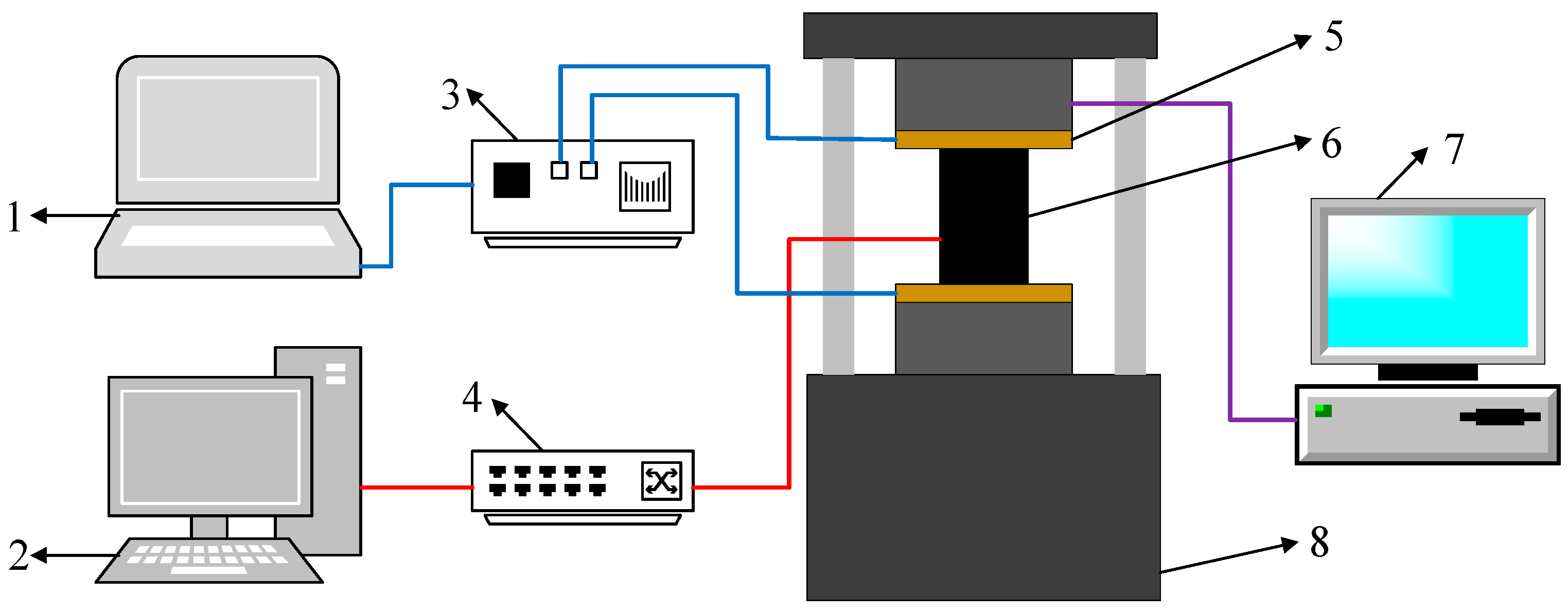
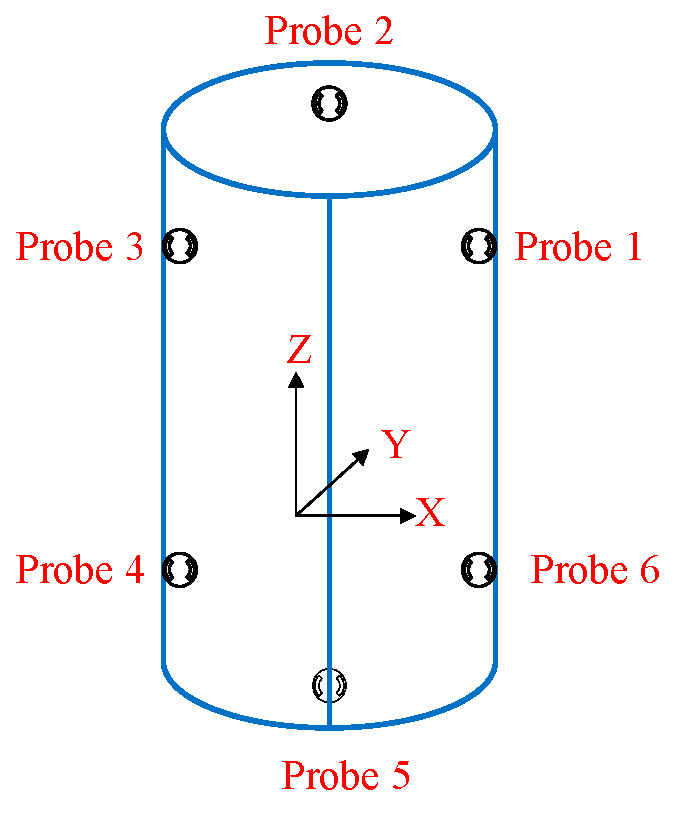
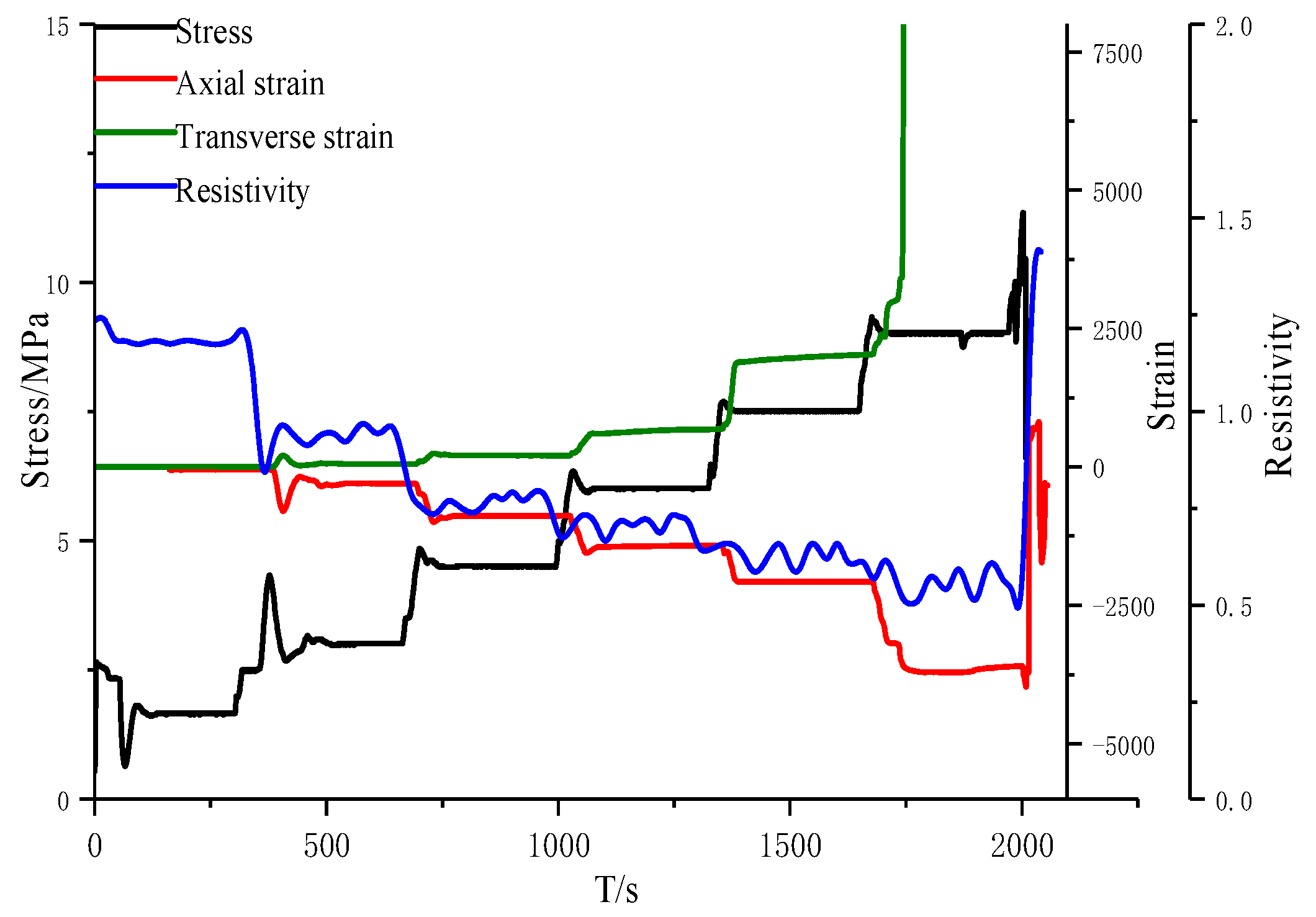
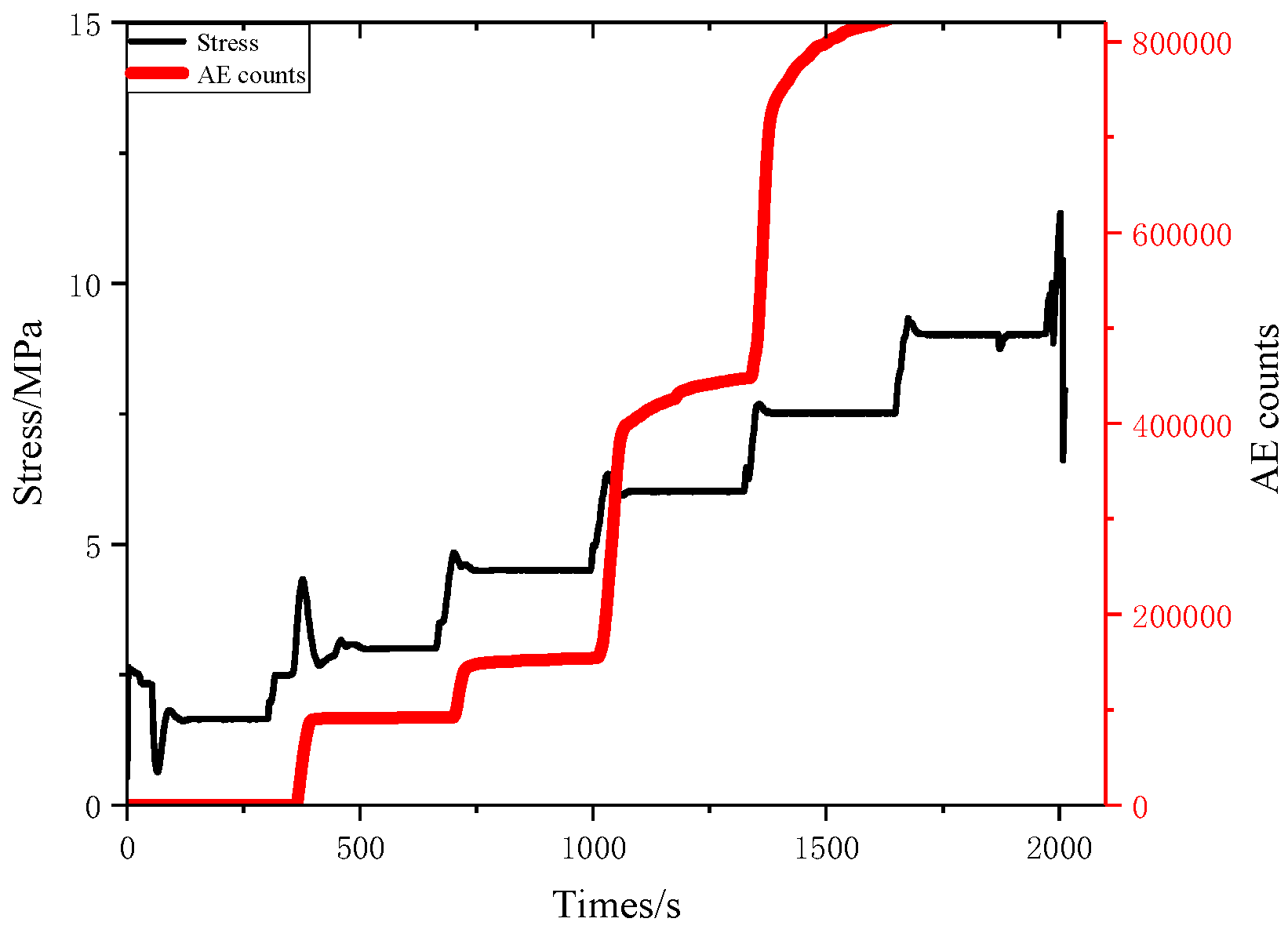

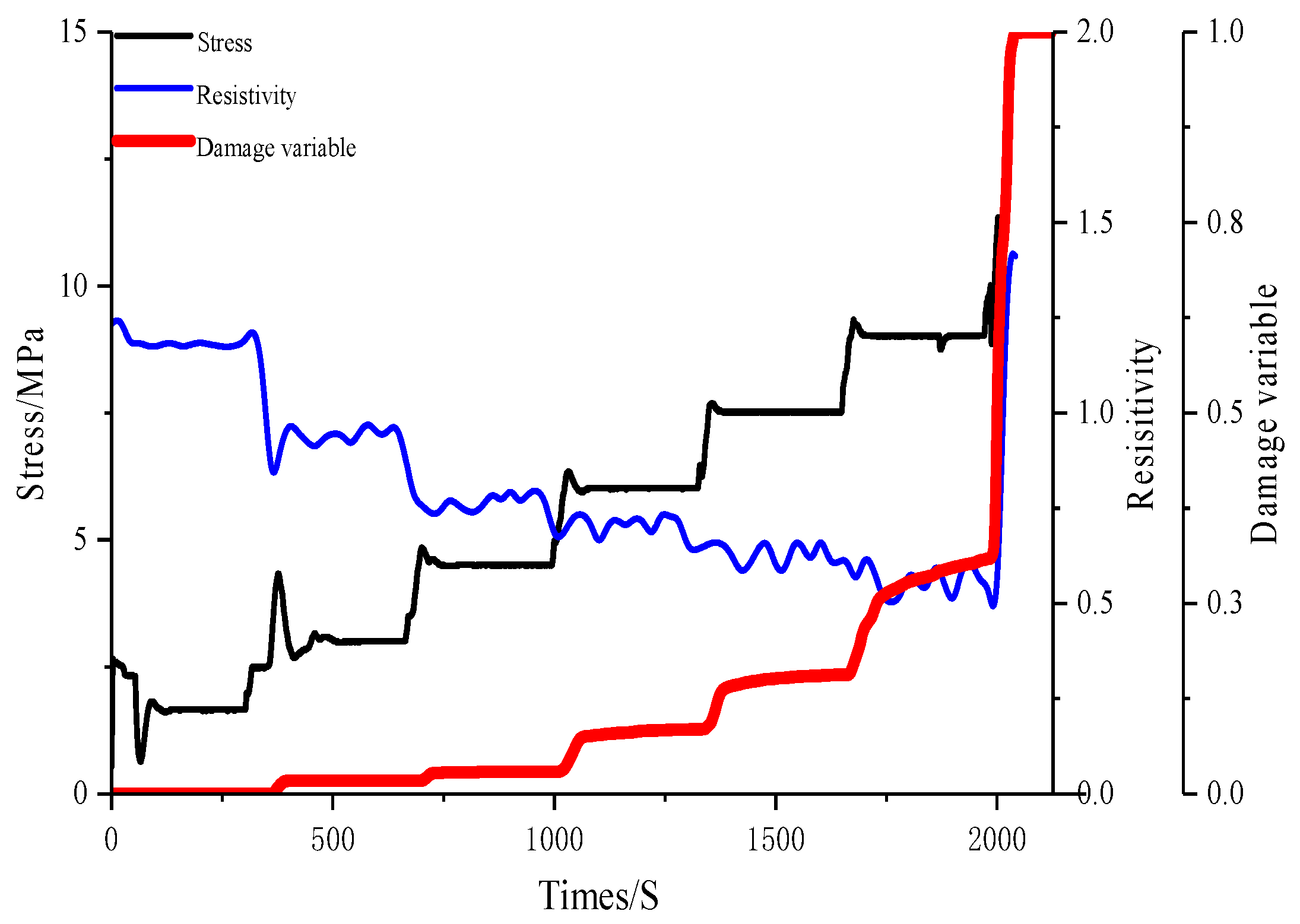
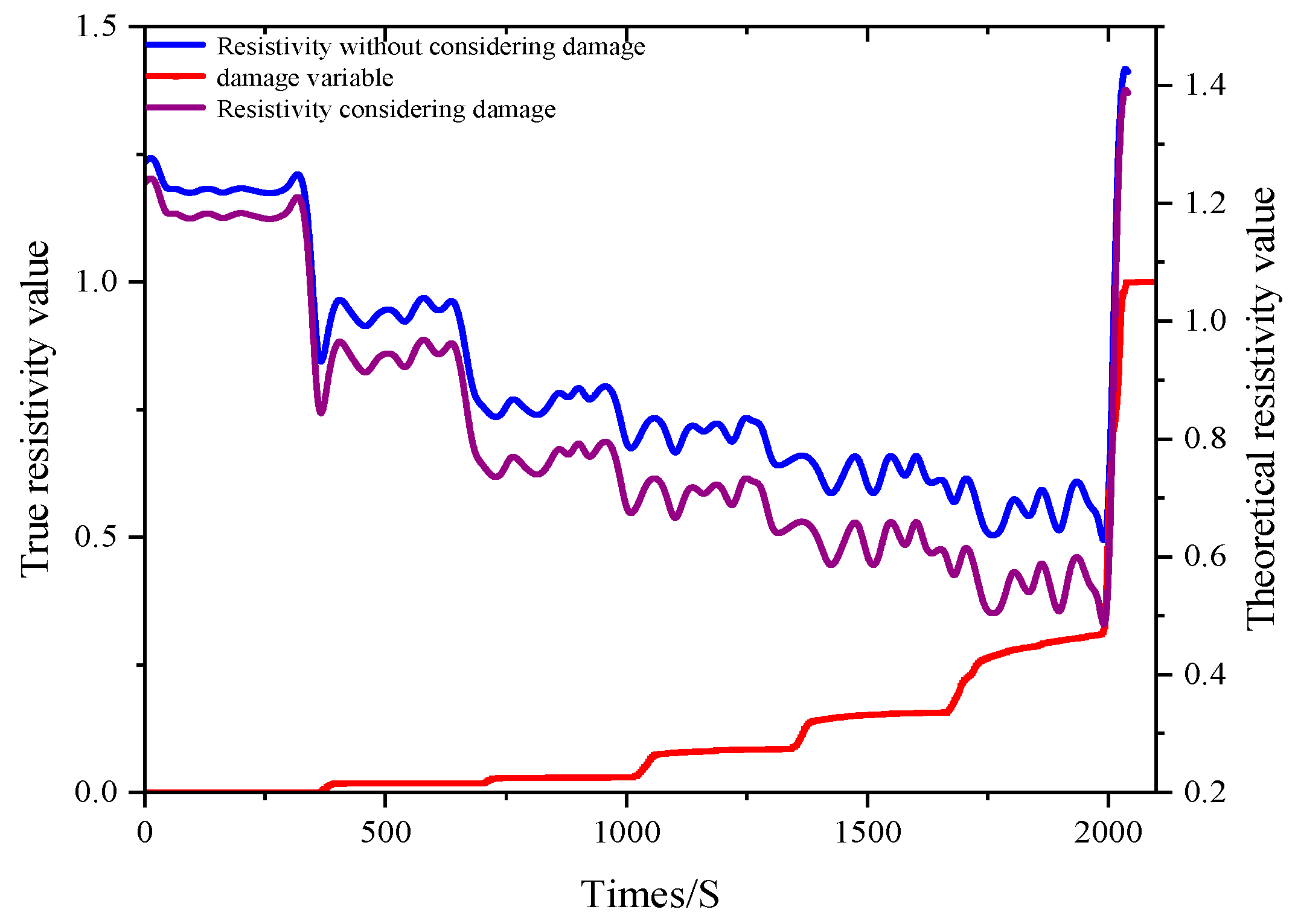
© 2019 by the authors. Licensee MDPI, Basel, Switzerland. This article is an open access article distributed under the terms and conditions of the Creative Commons Attribution (CC BY) license (http://creativecommons.org/licenses/by/4.0/).
Share and Cite
Li, X.; Zhang, Q. Study on Damage Evolution and Resistivity Variation Regularities of Coal Mass Under Multi-Stage Loading. Appl. Sci. 2019, 9, 4124. https://doi.org/10.3390/app9194124
Li X, Zhang Q. Study on Damage Evolution and Resistivity Variation Regularities of Coal Mass Under Multi-Stage Loading. Applied Sciences. 2019; 9(19):4124. https://doi.org/10.3390/app9194124
Chicago/Turabian StyleLi, Xiangchun, and Qi Zhang. 2019. "Study on Damage Evolution and Resistivity Variation Regularities of Coal Mass Under Multi-Stage Loading" Applied Sciences 9, no. 19: 4124. https://doi.org/10.3390/app9194124




